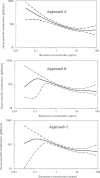Low-dose metabolism of benzene in humans: science and obfuscation
- PMID: 23222815
- PMCID: PMC3584950
- DOI: 10.1093/carcin/bgs382
Low-dose metabolism of benzene in humans: science and obfuscation
Abstract
Benzene is a ubiquitous air pollutant that causes human leukemia and hematotoxic effects. Although the mechanism by which benzene causes toxicity is unclear, metabolism is required. A series of articles by Kim et al. used air and biomonitoring data from workers in Tianjin, China, to investigate the dose-specific metabolism (DSM) of benzene over a wide range of air concentrations (0.03-88.9 p.p.m.). Kim et al. concluded that DSM of benzene is greatest at air concentrations <1 p.p.m. This provocative finding motivated the American Petroleum Institute to fund a study by Price et al. to reanalyze the original data. Although their formal 'reanalysis' reproduced Kim's finding of enhanced DSM at sub-p.p.m. benzene concentrations, Price et al. argued that Kim's methods were inappropriate for assigning benzene exposures to low exposed subjects (based on measurements of urinary benzene) and for adjusting background levels of metabolites (based on median values from the 60 lowest exposed subjects). Price et al. then performed uncertainty analyses under alternative approaches, which led them to conclude that '… the Tianjin data appear to be too uncertain to support any conclusions …' regarding the DSM of benzene. They also argued that the apparent low-dose metabolism of benzene could be explained by 'lung clearance.' In addressing these criticisms, we show that the methods and arguments presented by Price et al. are scientifically unsound and that their results are unreliable.
Figures






Comment on
-
A reanalysis of the evidence for increased efficiency in benzene metabolism at airborne exposure levels below 3 p.p.m.Carcinogenesis. 2012 Nov;33(11):2094-9. doi: 10.1093/carcin/bgs257. Epub 2012 Jul 28. Carcinogenesis. 2012. PMID: 22843549
References
-
- IARC (2012). Chemical Agents and Related Occupations, Volume 100 F, A Review of Human Carcinogens, International Agency for Research on Cancer; Lyon, France:
-
- Ross D. (2000). The role of metabolism and specific metabolites in benzene-induced toxicity: evidence and issues. J. Toxicol. Environ. Health Part A, 61, 357–372 - PubMed
Publication types
MeSH terms
Substances
Grants and funding
LinkOut - more resources
Full Text Sources
Medical

